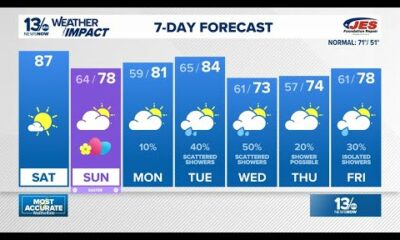News from the South - Florida News Feed
Little tracking, wide variability permeate the teams tasked with stopping school shootings • Florida Phoenix
Little tracking, wide variability permeate the teams tasked with stopping school shootings
by Cheryl Platzman Weinstock, Florida Phoenix
January 31, 2025
Max Schachter wanted to be close to his son Alex on his birthday, July 9, so he watched old videos of him.
“It put a smile on my face to see him so happy,” Schachter said.
Alex would have turned 21 that day, six years after he and 16 other children and staff at Marjory Stoneman Douglas High School in Parkland, Florida, were shot and killed by a former student in 2018. In the years before the shooting, that former student had displayed concerning behavior that elicited dozens of calls to 911 and at least two tips to the FBI.
“Alex should still be here today. It’s not fair,” Schachter said.
After two weeks of grieving Alex’s death, Schachter, propelled by anger and pain, began advocating for school safety. In part, he wanted to ensure his three other children would never be harmed in the same way. He joined the newly formed Marjory Stoneman Douglas High School Public Safety Commission to improve the safety and security of Florida’s students. And he launched a nonprofit bearing Alex’s name, which advocates for school safety.
Doing that work, he learned about threat assessment teams, groups of law enforcement and school officials who try to identify potentially dangerous or distressed kids, intervene, and prevent the next school shooting. Florida is one of about 18 states that require schools to have threat assessment and intervention teams; a national survey estimates 85% of public schools have a team assigned to the task.
The teams, whose mission and operational strategies often are based on research from the FBI and the Secret Service’s National Threat Assessment Center, or NTAC, have become more common as the number of school shootings has increased. Despite their prevalence for almost 25 years, some of the teams have developed systemic problems that put them at risk of unfairly labeling and vilifying children.
States vary widely in their requirements of threat assessment teams and there isn’t a nationwide archetype. Few school districts and states collect data about the teams, little is known about their operations, and research on their effectiveness at thwarting mass shootings and other threats is limited. But a 2021 analysis by the NTAC of 67 plots against K-12 schools found that people “contemplating violence often exhibit observable behaviors, and when community members report these behaviors, the next tragedy can be averted.”
“School shooters have a long thought process. They don’t just snap. They have concerning behavior over time. If we can identify them early, we can intervene,” said Karie Gibson, chief of the FBI’s Behavioral Analysis Unit.
Yet, Dewey Cornell, a forensic clinical psychologist who in 2001 developed one of the first sets of guidelines for school threat assessment teams, said there have been problems. In many cases, he said, threats have been deemed not serious “but parents and teachers are so alarmed that it is difficult to assuage their fears. The school community gets in an uproar and the school administrators feel pressured to expel the student.”
And in other cases, a school doesn’t do a threat assessment and assumes a student is dangerous when somebody else reports them as a threat, and they may take a zero-tolerance approach and remove them from the school, said Cornell, the Virgil S. Ward professor of education at the University of Virginia.
A task force convened by the American Psychological Association found little evidence that zero-tolerance policies have improved school climate or school safety and said they may create negative mental health outcomes for students. The task force cited examples of students who were expelled for incidents or school rule violations as minor as having a knife in their lunch box for cutting an apple.
Several states, including Florida, require schools to assemble teams of law enforcement and education officials to identify students who could become mass shooters and intervene before it’s too late. But some experts say the efforts often face a lack of guidance and significant pressure, putting them at risk of maligning innocent students.
Marisa Randazzo, a research psychologist and the director of threat assessment for Georgetown University, said she has also seen “hyperreactions,” especially among school communities that have experienced a mass killing.
“It’s understandable. People who have been close to an event like this are on higher alert than other people,” said Randazzo, who previously worked for the Secret Service and co-founded Sigma Threat Management Associates.
Threat assessments are supposed to be a graduated process calibrated to the seriousness of a problem, since the majority of student threats are not credible and can be resolved through supportive interventions, according to research from the Secret Service.
Stephanie Crawford-Goetz, a school psychologist and the director of mental health for student support services in the Douglas County School District in Colorado, where a shooting occurred at a charter school in 2019, said her district’s threat assessment process emphasizes a proactive, rehabilitative approach to managing potential threats, as the NTAC suggests.
Crawford-Goetz said her district interviews students before convening the team to assess whether a threat is a misguided expression of anger or frustration and if the student has a plan and means to carry out violence.
Students whose threats are deemed transient receive support, such as help with coping skills, and they may meet with a mental health provider.
If the threat is credible, a student may be temporarily removed from the classroom or school.
Randazzo said the vast majority of kids who make threats are suicidal or despondent: “The process is designed primarily to figure out if someone is in crisis and how we can help. It is not designed to be punitive.”
Crawford-Goetz tells parents about her district’s threat assessment team at the beginning of the school year. Some districts report keeping their teams a secret from parents, which is not how they were designed to operate, said Lina Alathari, chief of the NTAC. Her team encourages schools to educate the whole community about the threat assessment process.
Some advocacy groups contend that threat assessment teams have perpetuated inequities. There has also been widespread concern that children with disabilities can easily get swept into a threat assessment.
In a 2022 report, the National Disability Rights Network, a nonprofit based in Washington, D.C., said some threat assessment teams have become “judge, jury, and executioner,” going beyond assessing risk of serious, imminent harm to determining guilt and punishment.
Expanding their scope allows threat assessment teams to get around civil rights protections, the report says.
Cornell disputed the disability rights group’s conclusion. “This has not been corroborated by scientific studies and is speculative,” he said.
Some states, such as Florida, mandate that threat assessment teams determine whether a student’s disability played a role in their behavior and recommend they include special education teachers and other professionals in their evaluation.
In Texas, which has mandated threat assessment teams, a third of students subjected to threat assessments in the Dallas Independent School District receive special education services.
Yet, the district doesn’t have a special education staff representative on its threat assessment team, according to a March 2023 report by Texas Appleseed, a nonprofit public interest justice center.
Many school districts are developing their own models in the absence of national standards for threat assessments.
Florida revamped its threat assessment system in January 2024 to improve response times, provide consistent data collection, and build in more checks and balances and oversight, said Pinellas County Sheriff Bob Gualtieri, who is also chair of the Marjory Stoneman Douglas High School Public Safety Commission.
The new model requires the teams to work quickly and file uniform, electronic summary reports of threat assessment findings. Those results follow students throughout their school years.
The adjustments are intended to eliminate the risk of not knowing about a student’s past troubling behavior if they change schools, as occurred with the Parkland shooter and a student who shot and killed classmates at a high school near Winder, Georgia, in September, said Gualtieri.
“As parents, you never stop worrying about your kids,” Schachter said.
Virginia mandates that all public schools and higher education institutions, including colleges, have threat assessment teams. In Florida, where one of Schachter’s daughters attends college, threat assessment teams are mandated in all public schools, including charter schools.
“There’s more work to be done,” Schachter said.
Cheryl Platzman Weinstock’s reporting is supported by a grant from the National Institute for Health Care Management Foundation.
KFF Health News is a national newsroom that produces in-depth journalism about health issues and is one of the core operating programs at KFF — the independent source for health policy research, polling, and journalism.
YOU MAKE OUR WORK POSSIBLE.
Florida Phoenix is part of States Newsroom, a nonprofit news network supported by grants and a coalition of donors as a 501c(3) public charity. Florida Phoenix maintains editorial independence. Contact Editor Michael Moline for questions: info@floridaphoenix.com.
News from the South - Florida News Feed
Orlando Dreamers secure $1.5 billion in funding
SUMMARY: The Orlando Dreamers have secured nearly $1.5 billion in funding to pursue a Major League Baseball team, marking a significant step for the initiative. Co-founder Jim Schnorf announced that investors have provided preliminary commitments, signaling serious intent to bring baseball to Central Florida. This funding is separate from the $1 billion earmarked for a proposed stadium near SeaWorld. As the Tampa Bay Rays struggle with their current stadium situation, Dreamers are watching closely, confident that Orlando is a prime location for an MLB franchise, whether through relocation or expansion.

The Orlando Dreamers have secured nearly $1.5 billion in investor commitments to bring a Major League Baseball team to Central Florida.
Subscribe to FOX 35 Orlando: https://bit.ly/3ACagaO
Watch FOX 35 Orlando LIVE newscasts: https://www.FOX35Orlando.com/live
Download FOX 35 news & weather apps: https://www.fox35orlando.com/apps
FOX 35 Orlando delivers breaking news, live events and press conferences, investigations, politics, entertainment, business news and local news stories and updates from Orlando, Orlando metro, and across Florida.
Watch more from FOX 35 on YouTube
Newest videos: https://www.youtube.com/myfoxorlando/videos
Most viewed/viral videos: https://www.youtube.com/watch?v=jgNn6rfByAM&list=PLzmRitN2dDZvlKw0C1IH3nLFGlbqgvp5C
We Love Florida: https://www.youtube.com/playlist?list=PLzmRitN2dDZuWecugac4QebPGp5-HZ5XP
Central Florida’s True Crime Files: https://www.youtube.com/watch?v=QAxwHLIeahA&list=PLzmRitN2dDZvk9zWypuHs9n38zuwnUSpx
More news stories: http://www.FOX35Orlando.com
Watch FOX 35 News live: https://fox35orlando.com/live
FOX 35 News newsletter: https://www.fox35orlando.com/email
Follow FOX 35 Orlando on Facebook: https://www.facebook.com/FOX35Orlando
Follow FOX 35 Orlando on Twitter: https://twitter.com/fox35orlando
Follow FOX 35 Orlando on Instagram: https://www.instagram.com/fox35orlando
News from the South - Florida News Feed
Tax Cut Disagreement Threatens to Extend Florida’s Legislative Session
SUMMARY: As Florida’s legislative session nears its end, lawmakers are at an impasse over a tax cut package, with only seven days remaining. The main issue revolves around budget negotiations, specifically the details and extent of tax cuts. Both Senate President Ben Albritton and House Speaker Danny Perez acknowledge philosophical differences in their approaches. The House proposed a cut to the sales tax while concerns arose about reallocating tourism funds. Governor Ron DeSantis favors property tax reductions. Despite tensions, leaders are hopeful for an agreement before the new budget deadline of July 1.
The post Tax Cut Disagreement Threatens to Extend Florida’s Legislative Session appeared first on www.abcactionnews.com
News from the South - Florida News Feed
Florida woman accused of setting fires during burn ban
SUMMARY: A Florida woman, Amanda Clark, was arrested for allegedly starting multiple fires during a burn ban. While the Forest Service was working to contain an existing fire near Oberry Hoover Drive, a worker witnessed Clark igniting new flames and instructed her to stop, but she continued. A nearby resident called 911 after seeing heavy smoke. Concerns grew in Palm Bay as additional fires emerged, prompting police to monitor the area. Assistant Fire Chief John Ringleb noted that multiple smoke columns appeared too dispersed to be linked. Palm Bay has since implemented a burn ban and plans to enforce it.

A woman was arrested Wednesday in Orange County for allegedly setting multiple fires during an active burn ban, according to deputies. Forestry officials say they witnessed Amanda Clark starting fires near a residence and recorded video evidence before she was taken into custody. She was booked into the Orange County Jail on charges of unlawful land burning, with bond set at $2,500. Her initial court appearance is scheduled for Thursday afternoon.
Subscribe to FOX 35 Orlando: https://bit.ly/3ACagaO
Watch FOX 35 Orlando LIVE newscasts: https://www.FOX35Orlando.com/live
Download FOX 35 news & weather apps: https://www.fox35orlando.com/apps
FOX 35 Orlando delivers breaking news, live events and press conferences, investigations, politics, entertainment, business news and local news stories and updates from Orlando, Orlando metro, and across Florida.
Watch more from FOX 35 on YouTube
Newest videos: https://www.youtube.com/myfoxorlando/videos
Most viewed/viral videos: https://www.youtube.com/watch?v=jgNn6rfByAM&list=PLzmRitN2dDZvlKw0C1IH3nLFGlbqgvp5C
We Love Florida: https://www.youtube.com/playlist?list=PLzmRitN2dDZuWecugac4QebPGp5-HZ5XP
Central Florida’s True Crime Files: https://www.youtube.com/watch?v=QAxwHLIeahA&list=PLzmRitN2dDZvk9zWypuHs9n38zuwnUSpx
More news stories: http://www.FOX35Orlando.com
Watch FOX 35 News live: https://fox35orlando.com/live
FOX 35 News newsletter: https://www.fox35orlando.com/email
Follow FOX 35 Orlando on Facebook: https://www.facebook.com/FOX35Orlando
Follow FOX 35 Orlando on Twitter: https://twitter.com/fox35orlando
Follow FOX 35 Orlando on Instagram: https://www.instagram.com/fox35orlando
-

 News from the South - Florida News Feed5 days ago
News from the South - Florida News Feed5 days agoJim talks with Rep. Robert Andrade about his investigation into the Hope Florida Foundation
-

 News from the South - Virginia News Feed7 days ago
News from the South - Virginia News Feed7 days agoHighs in the upper 80s Saturday, backdoor cold front will cool us down a bit on Easter Sunday
-

 News from the South - Arkansas News Feed7 days ago
News from the South - Arkansas News Feed7 days agoValerie Storm Tracker
-

 News from the South - Kentucky News Feed6 days ago
News from the South - Kentucky News Feed6 days agoU.S. Supreme Court pauses deportations under wartime law
-

 Mississippi Today5 days ago
Mississippi Today5 days ago‘Trainwreck on the horizon’: The costly pains of Mississippi’s small water and sewer systems
-

 News from the South - Alabama News Feed4 days ago
News from the South - Alabama News Feed4 days agoPrayer Vigil Held for Ronald Dumas Jr., Family Continues to Pray for His Return | April 21, 2025 | N
-

 News from the South - Texas News Feed5 days ago
News from the South - Texas News Feed5 days agoMeteorologist Chita Craft is tracking a Severe Thunderstorm Warning that's in effect now
-

 Mississippi Today7 days ago
Mississippi Today7 days agoOn this day in 1977, Alex Haley awarded Pulitzer for ‘Roots’














































